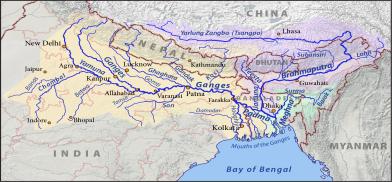Rivers as network: Towards a pluriverse South Asia
The Indus, the Brahmaputra, and the Ganges, as well as the Kabul river basin, which is interconnected to South Asian nations, are perennial rivers that have shaped and influenced South Asia's history, politics, culture, economy, and civilizations for many millennia on a shared basis.

Rivers in South Asia have a transboundary nature, flowing across political boundaries from one nation to another. The Hindu Kush and Himalayan mountain ranges separate South Asia from the rest of the continent, forming an enormous freshwater reservoir that flows through twenty major rivers shared by India, Pakistan, Bangladesh, Bhutan, Nepal, and Afghanistan. River’s history in South Asia is extensive and varied, which can lead to an array of reality anchored in the ground. The human populace and rivers have complimented each other since the dawn of civilization. The Indus River served as the spine of the Harrapan Civilization spanning from northeast Afghanistan to Pakistan and northwest India became essentially the foundation of modern-day South Asia; the region has always been a tight land mass. The Indus, Ganges, and Brahmaputra in South Asia are three of the great rivers that have spanned the growth of civilization. Since this region's human development was based on flowing rivers, the civilization of South Asia is usually referred to as a river-centric civilization.
Against this backdrop, river management in South Asia has been strained by a hairbreadth attitude that depletes the relationship between water and people, segregating historical and cultural channels in modern times. The narrow centrism owned by particular interest-seeking attributes narrated a one-world reality of modern South Asia, ignoring a number of worlds in the grounded reality to which the term pluriverse alludes. Since 1849, when the East India Company remodeled the dominant power structure in the newly annexed Punjab with an eye toward an economic interest that corresponds with elites' interest-seeking agendas, river management in South Asia has been plagued by an economic and business policy with politically infused interests. Punjab administration's attempt to lessen local communal ownership and commercialize agriculture through irrigation projects while individualizing property rights. Political demarcation processes, most notably the partition in 1947, strengthened the control over the predominant aspects of sharing, using, and making decisions. It gets pertinent when considering how Pakistan and India reacted to sharing the Indus' water after expanding outwards.
At the same time, as there is only one working water treaty, Bangladesh, which shares 54 rivers with India, also suffered from this political demarcation during the same period. Also, the construction of barrages across South Asian rivers in which each barrage has a specific purpose that benefits only the state that plans to construct it and does so without regard for the interests of those on the other side of the barrage. For instance, the one-way economic interest served by the Farakka over the Ganges between India and Bangladesh. The goal of a variety of economic development projects like electricity generation, irrigation, and flood control is considered as the premium development activities. This represents the modern river system not solely but in different ways with the same intent.
In South Asia, the intention of river management systems is also considered from environmental aspects on how to regulate flood and drought to safeguard people and material life through the construction of dams to divert the water channel. However, the politicization of dam-building efforts as a result of the state-centric apparatus is extremely troublesome for South Asia. Even though the construction of dams in South Asia has a colonial past where one interest exploits another without knowing the river. So, river water sharing management in terms of building dams can’t be an appropriate tool in any aspect when it is subsumed by politically driven characteristics.
Poor river management system
As such, it is time to bring up this subject in sight of conversations about sovereignty over water and how the sovereign power of a state can have a major impact on another neighbouring country when it comes to river water sharing management. The state strives to control river water sharing management by building dams and barrages for the sake of its own survival and that of its citizens, because a state is responsible for protecting its citizens. When it comes to water sharing, the sovereignty of a state has not been discussed in this instance substantially and is often debated. It becomes apparent when a state's safe haven for its citizens poses a threat to another neighbouring country even without considering the ecology of the river. Also heightening fact is that the current scenario does not imply that the upstream nations attempt to construct a dam, but rather that both the upstream and downstream nations actively encourage the construction of dams in order to boost economic growth in light of the economy's slow modernization. South Asia's river management system has become politically and commercially entangled. It is also noteworthy that the pattern of South Asia's river management is driven by a weak governmental and administrative structure.
Against all odds, the river retains a distinct geographical position, flowing from one country to another, negating the borderline. Even attempts to build dams are unable to stop the river's geographical flow, which signifies the river has multiple aptitudes to create a network against the politically motivated state-based demarcation through the border. As such, The Indus, the Brahmaputra, and the Ganges, as well as the Kabul river basin, which is interconnected to South Asian nations, are perennial rivers that have shaped and influenced South Asia's history, politics, culture, economy, and civilizations for many millennia on a shared basis. These rivers supported millions of people and their different economic systems while also being revered as holy by locals of various religious beliefs. Even in cultivation, river water is supplied by the inundation and perennial canals, which are connected by nearby rivers, particularly the Ravi, Sutlej, Indus, and Chenab.
Thus, rivers are connected to people-to-people communication, even in relations, through history, culture, and social and religious beliefs, multiplying with a spectrum of the world that might be alluded to as a river network. But the river management system in South Asia has been marred by a single reality, in which the state is the main player and navigates the river for its own interest, creating sometimes a situation that is incompatible with the circumstances on the other side.
Reimagining South Asia through rivers
Rather, it is not confined by one world reality when it returns to the history of the river where it corresponds with a variety of subjective representations. When the river is the central aspect of river management rather than the state, that represents the river in which a plurality of truths and perspectives can be represented. In this way, if the river becomes a centre rather than a state, it can incorporate factors at play with the river, while the operationalization of the river by the state will serve to produce another separate kind of reality.
South Asian rivers are interconnected historically, socially, and culturally in addition to geographically (upstream and downstream closeness). There are numerous absolutes that have been transformed by rivers that connect people from all across South Asia and allow them to share common impulses. "Rivers" in this context refers to a system of connections building a network that can allow the South Asian Pluriverse by drawing multiple meanings but grounded in georaphical reality. The region's rivers have a value-laden role ranging from religion and culture to commerce and government. The river system in South Asia has multiple possibilities that can be harnessed to imagine how modern South Asia can develop in the future.
(The author is a Ph.D. Candidate, Department of International Relations, South Asian University, New Delhi. Views are personal. He can be contacted at anupkumarsaha@students.sau.ac.in)














Post a Comment